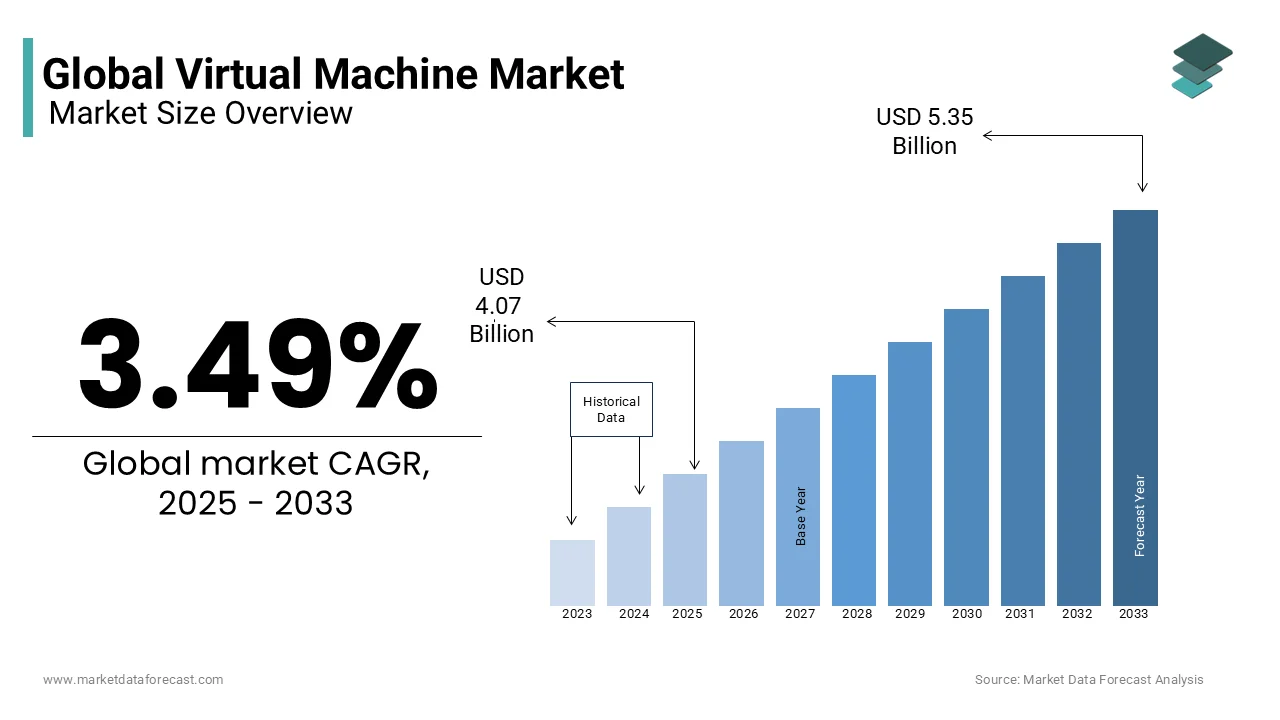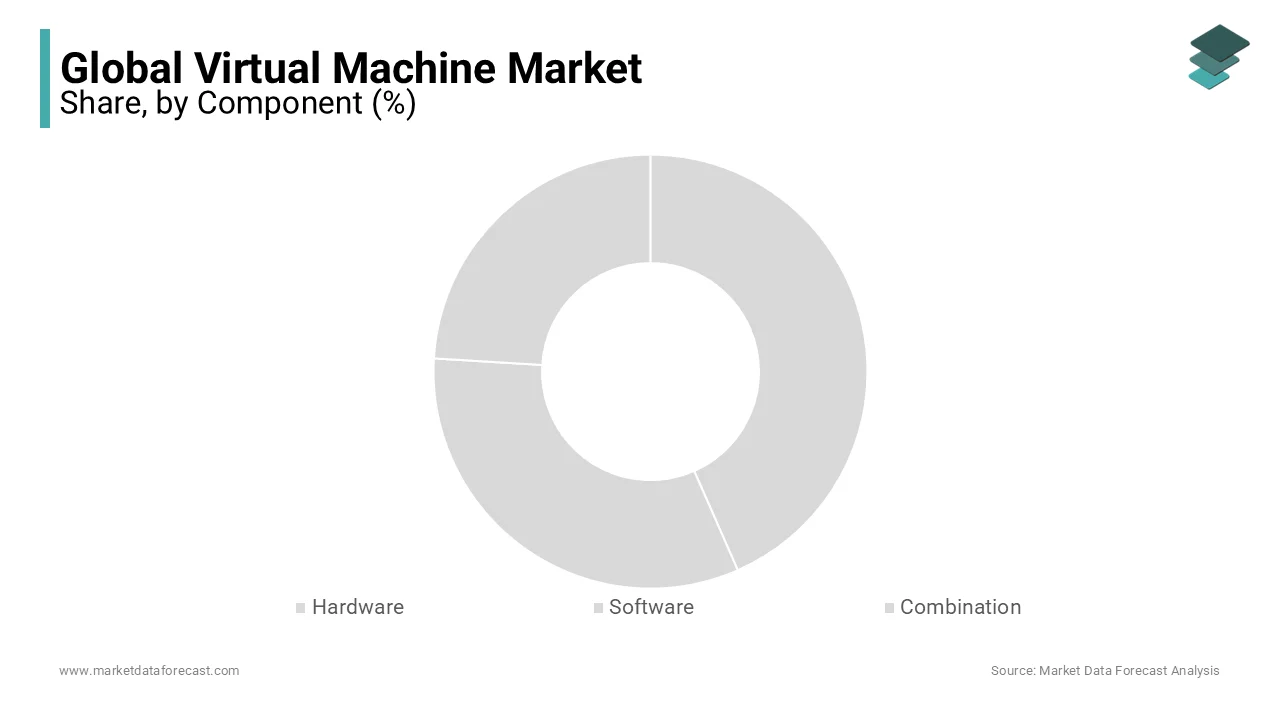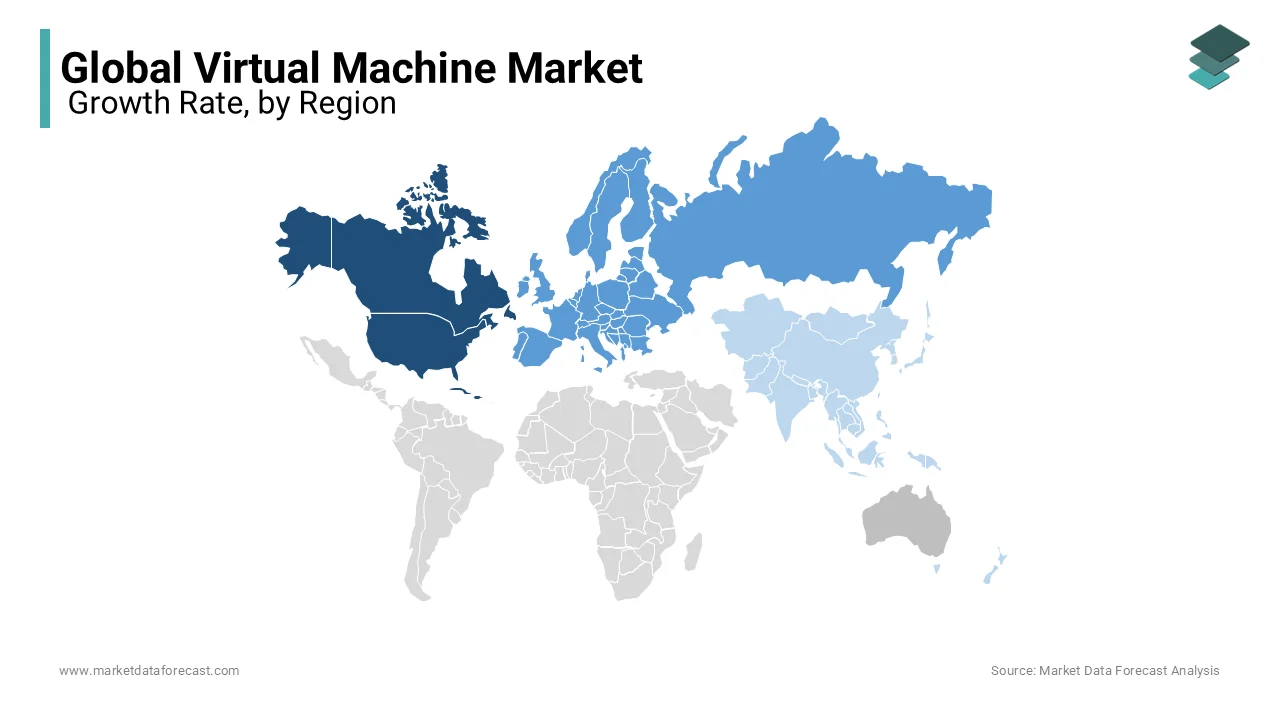Global Virtual Machine Market Size, Share, Trends, & Growth Forecast Report – Segmented By Type (System Virtual Machines and Process Virtual Machines), Application (Small Scale Enterprises, Medium Scale Enterprises and Large Scale Enterprises) & Region - Industry Forecast From 2024 to 2032
Global Virtual Machine Market Size (2024 to 2032)
The global virtual machine (VM) market was worth USD 3.82 billion in 2023, and it is predicted to grow from USD 3.93 billion in 2024 to USD 5.17 billion by 2032, with a CAGR of 3.49% between 2024 and 2032.

A software implementation of a computer machine is defined as a virtual machine (VM). It creates a distinct replica of a genuine computer that allows users to do activities in the same way that they would on a real computer. It is a piece of software that can not only simulate the behaviour of a different computer but also conduct functions such as launching programs and apps on that computer. These machines are used to install one operating system [OS] on top of another operating system [OS] on the same computer. These machines can be set up via firmware, hardware, software, or a mix of these methods. Organizations can have a variety of virtual machines (VMs) running different operating systems and store them all on a single host machine, which can be monitored using a hypervisor. As a result of the rising complexity of modern computing systems as a result of tightly interacting hardware and software components, virtual machines (VMs) are gaining in popularity. Virtualization serves as an interconnection technique, allowing incompatible systems to communicate with one another.
CURRENT SCENARIO
In the current professional environment, virtualisation technology provides numerous benefits. The capability to perform various workloads enables maximum utilization of physical server resources. Moreover, in any cloud setting, VMs are the prime computing resource. Presently, these cloud VMs are a case of Infrastructure-as-a-Service (IaaS) and are the most well-known type of virtualization. Other cloud variants such as Software-as-a-Service (SaaS), Platform-as-a-Service (PaaS), and a few latest variants like Function-as-a-Service (FaaS) and Database-as-a-Service (DBaaS) all employ virtual machines.
- According to Zadara, about 48 per cent of virtual machines are Linux, Windows (Server) accounts for 52 per cent of VMs, and 115GiB of SSD OS disk is its average size.
Additionally, the market also witnessed recent developments in technologies for cloud VMs, including Bare Metal Instances, Spot Instances, GPU-Enabled Instances, ARM-based Instances, and Confidential Computing. These advancements are believed to propel the market forward. Also, containers gained traction as a preferred method for deploying microservices.
Besides this, the market is experiencing a rise due to the application of VMs in blockchain technology. The Ethereum Virtual Machine (EVM) is the leading in this market in the blockchain ecosystem.
MARKET DRIVERS
The rise in benefits, such as data security against disaster and increased application utilization, is likely to propel the virtual machine market forward in the foreseeable era. The main goal of virtualization is to optimise management tasks and improve scalability and volume of work, it also acts as a robust tool for enhancing security. Virtualization offers a safe platform for extensive security testing and training operations, including replica environment and incident response training. Security personnel and experts can make duplicate environments that simulate production systems. These replicas comprise identical vulnerabilities, applications, and configurations. By utilizing virtualization, analysts and examiners can perform penetration tests, vulnerability tests, and security assessments in governed and risk-free conditions. This technique assists in detecting shortcomings and vulnerabilities before their exploitation by actual threats.
Furthermore, the virtual machine market is being driven by the convenience of use and simple maintenance replacements. These machines are extremely simple to manage, and there is no need to be concerned about the hardware or software configurations of every machine. The installation of VM software and development of fresh digital environments within some clicks. Moreover, the flexibility is another factor contributing to the market growth. This is one of the strengths of virtual machines in cloud computing. Since VMs are software-powered, it is simple to create new instances when required. This makes it highly easy to expand the computing resources based on the requirements without acquiring extra hardware.
Additionally, the market is expected to benefit from increased digitalization and continuous improvement in IT infrastructure.
MARKET RESTRAINTS
Issues with performance efficiency and productivity as a result of running many virtual machines on a single physical computer system are expected to stymie the virtual machine market's growth over the forecast period. Furthermore, the price efficiency to allow virtual machine sales would give additional potential prospects for market growth during the forecast period. However, the lack of isolation between different virtual machines may provide further difficulties to market expansion.
MARKET OPPORTUNITIES
The virtual machine market holds immense potential and is slated to thrive in the coming years. This can be attributed to emerging applications, including hybrid cloud environments, confidential computing, containerization, disaster recovery solutions, development and testing environments, desktop virtualization, etc. Its importance increases even more concerning the environmental and health impacts of e-waste. There are rising economic advantages of implementing a circular commercial approach for electronic waste.
- As per a recent estimate, over 50 million tons of electronic waste are abandoned every year. Out of this trash, just approximately 20 per cent is reprocessed.
Apart from this, a hybrid cloud setting presents potential opportunities for expansion of the market. Today, the application of hybrid cloud is rapidly surging, and within a span of a few years, this cloud type will completely dominate the market; in that scenario, the demand for virtual machines will escalate, considering the benefits it provides.
MARKET CHALLENGES
Hyper-jacking is believed to be one of the primary challenges for the expansion of the virtual machine market. Within server virtualisation, the hypervisor acts as a central security element, which, if compromised, can result in many consequences. Hyper-jacking includes deploying a malicious hypervisor to obtain control over a server and evading standard security protocols. Standard security protocols are inefficient because the operating system remains unaware that the machine has been breached.
- According to Microsoft, it identified around 147 thousand token replay attacks in 2023 which is a 111 per cent rise year-on-year (YoY). Attackers are progressively switching to session hijacking to bypass the extensive implementation of multi-factor authentication (MFA). Today, these attacks on session cookies occur in a similar range as password-based attacks.
REPORT COVERAGE
|
REPORT METRIC |
DETAILS |
|
Market Size Available |
2023 to 2032 |
|
Base Year |
2023 |
|
Forecast Period |
2024 to 2032 |
|
CAGR |
3.49% |
|
Segments Covered |
By Component, Product, Application and Region |
|
Various Analyses Covered |
Global, Regional & Country Level Analysis, Segment-Level Analysis, DROC, PESTLE Analysis, Porter’s Five Forces Analysis, Competitive Landscape, Analyst Overview on Investment Opportunities |
|
Regions Covered |
North America, Europe, APAC, Latin America, Middle East & Africa |
|
Market Leaders Profiled |
Oracle (US), IBM (US), Red Hat Software (US), Microsoft Corp (US), Citrix Systems (US), HP (US), Amazon Web Services Inc (US), Huawei Technologies (China), Inspur (China), New H3C Technologies Co Ltd (China), and others |
SEGMENTAL ANALYSIS
Global Virtual Machine Market Analysis By Component

During the projected period, the Software sector is expected to dominate the market. The fact that VMs are software computers and that the installation of a computer machine may be done with the software will lead to a high reliance on software in the sector, which will lead to a high demand for software, which will add to the segment's market share. Apart from this, VMware Workstation Pro, Oracle VirtualBox, Stratus zero-touch computing platforms, Parallels Desktop for Mac, and Microsoft Hyper-V are some of the best virtualisation software in 2024.
Global Virtual Machine Market Analysis By Product
During the projection period, the System virtual machines sector is expected to have a significant market share. System virtual machines have many advantages, such as the ability to run many OS environments in parallel on the same hardware while remaining isolated from one another. It can also give the instruction set architecture (ISA), which is slightly different from what an actual machine can deliver. The inclusion of these features in System virtual machines would increase the segment's market share.
Global Virtual Machine Market Analysis By Application
The market is expected to be dominated by large-scale businesses. Because major businesses have more resources than small and medium businesses, they are constantly focusing on infrastructural improvement to ensure improved productivity, which will lead to stronger demand for and use of virtual machines in these businesses.
The Small and Medium Enterprises [SME] segment, on the other hand, is expected to increase at a quicker rate. Despite having fewer resources than large-scale enterprises, due to the growing number of SMEs and increased competition to stay in business, these businesses are eager to follow the industry trend, which will result in the quick integration of virtual machines into their operations, contributing to the segment's growth rate. Furthermore, because SMEs have fewer organizational complications, it is easier for them to implement rapid infrastructure changes, which contributes to the segment's growth rate.
REGIONAL ANALYSIS

The global virtual machine market was dominated by North America, followed by Europe. Due to the growing number of data centers and the region's booming IT industry, Asia Pacific is expected to have the fastest growth rates during the forecast period.
In 2020, the value of virtual machines in the United States will have increased by over 11.8% annually. Because of the presence of important virtual machines and cloud computing service vendors in the region, the United States is expected to be one of the most lucrative markets in North America throughout the projection period. As organizations continue to transfer their complete server virtualization setup to the virtual cloud, virtual machine use in the United States has climbed by 2.5%. Furthermore, rising demand, particularly from the healthcare and manufacturing sectors, has fueled the expansion of the virtual machine market in the United States.
The United Kingdom, as a G7 economy, is one of the most developed IT and related services markets in the world, and it is one of the most important global markets for cloud computing. As one of the most advanced global marketplaces for cloud computing, the United Kingdom has a sizable company ecosystem serving the primary market, such as data centers and cloud VMs. Cloud computing is a major driver of the UK's data-driven economy, with cloud-based virtual machine platforms, infrastructure, and services assisting firms in every industry and sector.
China is one of the major cloud computing marketplaces in the world. Alibaba, Tencent, and Huawei are among the companies best positioned to profit from the opportunities that exist in China. With cloud infrastructure spending expected to skyrocket, China will entice some major industry players. In addition, the Chinese government is committed to growing the cloud computing sector in the country, which presents significant prospects for virtual machine vendors. The Chinese government is always focused on cloud and associated ICT technologies to improve digital transformation, which will boost the Chinese market.
The Indian cloud computing business is thriving, with all of the main global cloud providers, such as Amazon, Microsoft, IBM, Google, and others, all having a presence in the nation. Small and medium-sized businesses, as well as large corporations, are actively shifting to cloud-based virtualization technologies throughout the country. During the forecast period, the manufacturing sector in the Indian virtual machine market is expected to increase at a CAGR of 35%.
KEY MARKET PLAYERS
Companies playing a key role in the global virtual machine market include Oracle (US), IBM (US), Red Hat Software (US), Microsoft Corp (US), Citrix Systems (US), HP (US), Amazon Web Services Inc (US), Huawei Technologies (China), Inspur (China) and New H3C Technologies Co Ltd (China). VMware is the leading company in the global virtual machine market.
RECENT HAPPENINGS IN THE MARKET
- In September 2024, Parallels, a worldwide player in cross-platform virtualization solutions and products, announced the introduction of ‘Parallels Desktop 20 for Mac’. This newest version labels a considerable landmark with the launch of AI abilities, providing safe, downloadable AI-optimised virtual machines intended for offline management and operation to enhance AI application development. Completely interoperable with Windows 11 24H2 and macOS Sequoia, it also presents a management portal within the new Enterprise Edition, besides several updates for Linux VMs, macOS, and Windows.
- In June 2024, HPE reported the launch of a new HPE Virtualization Stack, incorporated into HPE GreenLake for Private Cloud Business Edition (HPE PCBE). This unique solution enables users to handle on-premises workloads with the convenience and effectiveness of a public cloud, providing an experience equivalent to HPE PCBE on VMware.
DETAILED SEGMENTATION OF THE GLOBAL VIRTUAL MACHINE MARKET INCLUDED IN THIS REPORT
This research report on the global virtual machine market has been segmented and sub-segmented based on component, product, application and region.
By Component
- Hardware
- Software
- Combination
By Product
- Process VM
- System VM
By Application
- Large
- SMEs
By Region
- North America
- Europe
- Asia-Pacific
- Latin America
- Middle East and Africa
Frequently Asked Questions
What are the key drivers of growth in the Virtual Machine market?
The primary drivers include the rising demand for cloud computing, the need for efficient and cost-effective IT infrastructure, increased digital transformation initiatives, and the growing emphasis on disaster recovery and business continuity.
Which industries are the largest users of Virtual Machines?
Key industries using Virtual Machines include IT and telecommunications, healthcare, banking and financial services, manufacturing, and retail. These sectors benefit from virtualization for scalability, efficiency, and cost savings.
What advancements are expected in the Virtual Machine market in the near future?
Expected advancements include improved VM security features, enhanced performance and efficiency, integration with artificial intelligence and machine learning, and the development of more user-friendly management tools.
How is the regulatory environment affecting the Virtual Machine market?
Regulations regarding data protection, privacy, and compliance (such as GDPR in Europe and HIPAA in the United States) are influencing the market. Companies must ensure their virtual environments comply with these regulations, which can impact deployment and management strategies.
Related Reports
Access the study in MULTIPLE FORMATS
Purchase options starting from $ 2500
Didn’t find what you’re looking for?
TALK TO OUR ANALYST TEAM
Need something within your budget?
NO WORRIES! WE GOT YOU COVERED!
Call us on: +1 888 702 9696 (U.S Toll Free)
Write to us: [email protected]